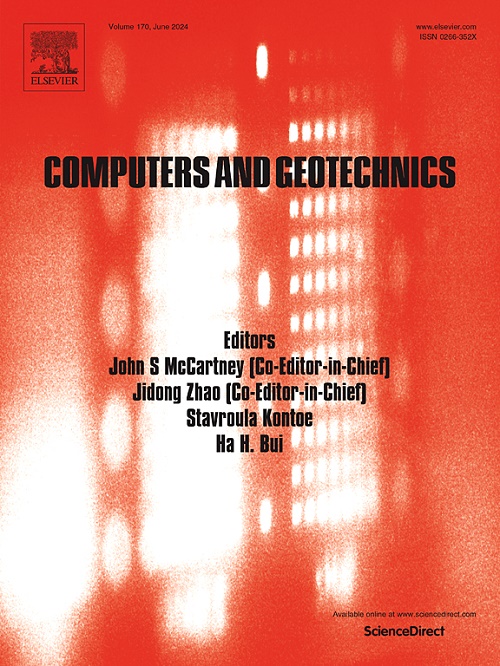将临界状态理论整合到颗粒材料的微观力学模型中,以解释织物的演化
IF 5.3
1区 工程技术
Q1 COMPUTER SCIENCE, INTERDISCIPLINARY APPLICATIONS
引用次数: 0
摘要
在岩土工程中,建立高效、准确的颗粒土本构模型至关重要。微力学模型因其考虑粒子尺度相互作用和织物各向异性的能力而受到广泛关注,同时与离散元方法相比,所需的计算资源要少得多。文献中提出了各种微观力学模型,但没有一种模型得到了理论证明,与临界状态理论一致,尽管作者描述他们的模型“近似”达到了临界状态。本文在假定细观力-剪胀关系应与宏观应力-剪胀关系一致的基础上,对先前与临界状态理论相容的CHY细观力学模型进行了修正。此外,在CHY模型的框架下,可以方便地考虑织物的各向异性,并通过引入织物的演化规律来实现各向异性的临界状态。通过排水和不排水三轴试验对模型进行了标定,结果表明该模型可靠地模拟了排水和不排水条件下颗粒材料的力学行为。在宏观和微观尺度上验证了该模型与临界状态理论的相容性。本文章由计算机程序翻译,如有差异,请以英文原文为准。
Integration of critical state theory into a micromechanical model for granular materials accounting for fabric evolution
In geotechnical engineering, the development of efficient and accurate constitutive models for granular soils is crucial. The micromechanical models have gained much attention for their capacity to account for particle-scale interactions and fabric anisotropy, while requiring far less computational resources compared to discrete element method. Various micromechanical models have been proposed in the literature, but none of them have been conclusively shown to agree with the critical state theory given theoretical proof, despite the authors described that their models “approximately” reach the critical state. This paper modifies the previous CHY micromechanical model that is compatible with the critical state theory based on the assumption that the microscopic force–dilatancy relationship should align with the macroscopic stress–dilatancy relationship. Moreover, under the framework of the CHY model, the fabric anisotropy can be easily considered and the anisotropic critical state can be achieved with the introduction of the fabric evolution law. The model is calibrated using drained and undrained triaxial experiments and the results show that the model reliably replicates the mechanical behaviors of granular materials under both drained and undrained conditions. The compatibility of the model with the critical state theory is verified at both macroscopic and microscopic scales.
求助全文
通过发布文献求助,成功后即可免费获取论文全文。
去求助
来源期刊

Computers and Geotechnics
地学-地球科学综合
CiteScore
9.10
自引率
15.10%
发文量
438
审稿时长
45 days
期刊介绍:
The use of computers is firmly established in geotechnical engineering and continues to grow rapidly in both engineering practice and academe. The development of advanced numerical techniques and constitutive modeling, in conjunction with rapid developments in computer hardware, enables problems to be tackled that were unthinkable even a few years ago. Computers and Geotechnics provides an up-to-date reference for engineers and researchers engaged in computer aided analysis and research in geotechnical engineering. The journal is intended for an expeditious dissemination of advanced computer applications across a broad range of geotechnical topics. Contributions on advances in numerical algorithms, computer implementation of new constitutive models and probabilistic methods are especially encouraged.
 求助内容:
求助内容: 应助结果提醒方式:
应助结果提醒方式:


